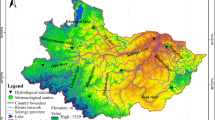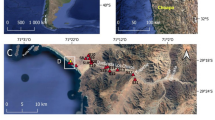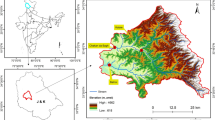Abstract
Lake sediment records the evolution process of the interaction between human and nature. It is important to master the lacustrine sedimentation rate for the ecological environment assessment of catchment. A 60-cm sediment core was collected in the Da River Reservoir during 2019 to analyze radionuclides (210Pb and 137Cs) massic activities, grain size, total organic carbon (TOC), total nitrogen (TN), total phosphorus (TP), and metals (Mn, Cu, Al, and Pb) mass fractions to reconstruct the response of sedimentation rate to environmental evolution. The environmental changes in the small catchment were classified into the following three stages through cluster analysis (CA) for geochemical parameters in the sediment core: phase I (1881–1985), phase II (1987–1999), and phase III (2000–2018). The average depth sedimentation rates (ADSRs) of the three stages were 0.33, 0.90, and 1.50 cm/year, respectively. The sedimentation rates increased from the bottom to the surface layer, indicating that the exogenous inputs into the reservoir have been occurring. The sediment deposition in phase III was strongly disturbed by the environmental changes (such as warmer climate and intensified land use). Therefore, sedimentation rates showed a rapid increase. Both Pearson correlation analysis and redundancy analysis (RDA) showed that sedimentation rates were positively correlated with climatic factors, particle size, nutrients and metals mass fractions, elemental ratios, and socioeconomic parameters. Sedimentation rates show high sensitivity to anthropogenic activities and climatic change, which can be used to reconstruct the environmental evolution process at a small catchment scale.








Similar content being viewed by others
Data availability
The datasets used and/or analyzed during the current study are available from the corresponding author on reasonable request.
References
Bai LF (2011) Study on ecological environment change and Kunming’s urban development in the Dianchi Lake Basin (1949–2009). Yunnan University, pp. 49–50
Bartley R, Thompson C, Croke J, Pietsch T, Baker B, Hughes K, Kinsey-Henderson A (2018) Insights into the history and timing of post-European land use disturbance on sedimentation rates in catchments draining to the Great Barrier Reef. Mar Pollut Bull 131:530–546
Begy RC, Savin CF, Kelemen S, Veres D, Muntean OL, Malos CV, Kovacs T (2021) Investigation of the effect of anthropogenic land use on the Pănăzii Lake (Romania) catchment area using Cs-137 and Pb-210 radionuclides. PloS one, 16
Bowen MW, Johnson WC (2019) Sediment accumulation and sedimentation rates in playas on the High Plains of western Kansas, USA. Geomorphology 342:117–126
Carpenter SR, Caraco NF, Correll DL, Howarth RW, Sharpley AN, Smith VH (1998) Nonpoint pollution of surface waters with phosphorus and nitrogen. Ecol Appl 8:559–568
Chai S, Gao L, Qiu D, Chai Y, Guo J, Xu X (2013) 210Pb and 137Cs dating of the sediment core and its recent accumulation rates in Yueliang Lake in west Jilin Province. J Jilin Univ (Earth Science Edition) 43:134–141
Chaparro MAE, Ramirez-Ramirez M, Chaparro MAE, Miranda-Aviles R, Puy-Alquiza MJ, Bohnel HN, Zanor GA (2020) Magnetic parameters as proxies for anthropogenic pollution in water reservoir sediments from Mexico: an interdisciplinary approach. Sci Total Environ 700:134343
Clark EV, Odhiambo BK, Ricker MC (2014) Comparative analysis of metal concentrations and sediment accumulation rates in two virginian reservoirs, USA: Lakes Moomaw and Pelham. Water Air Soil Pollut 225:1860
Crann CA, Patterson RT, Macumber AL, Galloway JM, Roe HM, Blaauw M, Swindles GT, Falck H (2015) Sediment accumulation rates in subarctic lakes: insights into age-depth modeling from 22 dated lake records from the Northwest Territories, Canada. Quat Geochronol 27:131–144
da Silva Cacho JC, Teixeira de Moura RS, Henry-Silva GG (2020) Influence of Nile tilapia (Oreochromis niloticus) fish farming in net cages on the nutrient and particulate matter sedimentation rates in Umari reservoir, Brazilian semi–arid. Aquacult Rep 17:100358
Dai X, Zhou Y, Ma W, Zhou L (2017) Influence of spatial variation in land-use patterns and topography on water quality of the rivers inflowing to Fuxian Lake, a large deep lake in the plateau of southwestern China. Ecol Eng 99:417–428
Dearing JA, Jones RT (2003) Coupling temporal and spatial dimensions of global sediment flux through lake and marine sediment records. Global Planet Change 39:147–168
Edwards KJ, Whittington G (2001) Lake sediments, erosion and landscape change during the Holocene in Britain and Ireland. CATENA 42:143–173
Emeis KC, Struck U, Leipe T, Pollehne F, Kunzendorf H, Christiansen C (2000) Changes in the C, N, P burial rates in some Baltic Sea sediments over the last 150 years-relevance to P regeneration rates and the phosphorus cycle. Mar Geol 167:43–59
Gellis AC, Fuller CC, Van Metre PC (2017) Sources and ages of fine-grained sediment to streams using fallout radionuclides in the Midwestern United States. J Environ Manage 194:73–85
Ghsoub M, Fakhri M, Courp T, Khalaf G, Buscail R, Ludwig W (2020) River signature over coastal area (Eastern Mediterranean): grain size and geochemical analyses of sediments. Reg Stud Mar Sci 35:101169
Gong Z, Li Y, Shen J, Xie P (2009) Diatom community succession in the recent history of a eutrophic Yunnan Plateau lake, Lake Dianchi, in subtropical China. Limnology 10:247–253
Houser JN, Mulholland PJ, Maloney KO (2006) Upland disturbance affects headwater stream nutrients and suspended sediments during baseflow and stormflow. J Environ Qual 35:352–365
Huang C, Wang X, Yang H, Li Y, Wang Y, Chen X, Xu L (2014) Satellite data regarding the eutrophication response to human activities in the plateau lake Dianchi in China from 1974 to 2009. Sci Total Environ 485–486:1–11
Jain CK, Singhal DC, Sharma MK (2005) Metal pollution assessment of sediment and water in the River Hindon, India. Environ Monit Assess 105:193–207
Jin Z, Han Y, Chen L (2010) Past atmospheric Pb deposition in Lake Qinghai, northeastern Tibetan Plateau. J Paleolimnol 43:551–563
Lan B, Zhang D, Yang Y (2018) Lacustrine sediment chronology defined by 137Cs, 210Pb and 14C and the hydrological evolution of Lake Ailike during 1901–2013, northern Xinjiang, China. CATENA 161:104–112
Lane SN, Bakker M, Costa A, Girardclos S, Loizeau JL, Molnar P, Silva T, Stutenbecker L, Schlunegger F (2019) Making stratigraphy in the Anthropocene: climate change impacts and economic conditions controlling the supply of sediment to Lake Geneva. Sci Rep 9:8904
Martin JM, Meybeck M (1979) Elemental mass balance of material carried by major world rivers. Mar Chem 7:173–206
Meyers PA (1997) Organic geochemical proxies of paleoceanographic, paleolimnologic, and paleoclimatic processes. Org Geochem 27:213–250
Mu D, Yuan D, Feng H, Xing F, Teo FY, Li S (2017) Nutrient fluxes across sediment–water interface in Bohai Bay Coastal Zone, China. Mar Pollut Bull 114:705–714
Nguyen TTH, Zhang W, Li Z, Li J, Ge C, Liu J, Bai X, Feng H, Yu L (2016) Assessment of heavy metal pollution in Red River surface sediments, Vietnam. Mar Pollut Bull 113:513–519
Odhiambo BK, Ricker MC (2012) Spatial and isotopic analysis of watershed soil loss and reservoir sediment accumulation rates in Lake Anna, Virginia, USA. Environ Earth Sci 65:373–384
Ojala AE, Luoto TP, Virtasalo JJ (2017) Establishing a high-resolution surface sediment chronology with multiple dating methods-testing Cs-137 determination with Nurmijarviclastic-biogenic varves. Quat Geochronol 37:32–41
Plater AJ, Boyle JF, Mayers C, Turner SD, Stroud RW (2006) Climate and human impact on lowland lake sedimentation in Central Coastal California: the record from c. 650 ad to the present. Reg Environ Change 6:71–85
Putyrskaya V, Klemt E, Röllin S, Corcho-Alvarado JA, Sahli H (2020) Dating of recent sediments from Lago Maggiore and Lago di Lugano (Switzerland/Italy) using 137Cs and 210Pb. J Environ Radioact 212:106135
Ritchie JC, McHenry JR (1990) Application of radioactive fallout cesium-137 for measuring soil erosion and sediment accumulation rates and patterns: a review. J Environ Radioac 19:215–233
Rose NL, Morley D, Appleby PG, Battarbee RW, Alliksaar T, Guilizzoni P, Jeppesen E, Korhola A, Punning J (2011) Sediment accumulation rates in European lakes since AD 1850: trends, reference conditions and exceedence. J Paleolimnol 45:447–468
Routh J, Meyers PA, Hjorth T, Baskaran M, Hallberg R (2007) Sedimentary geochemical record of recent environmental changes around Lake Middle Marviken, Sweden. J Paleolimnol 37:529–545
Sanchez-Cabeza JA, Ruiz-Fernández AC (2012) 210Pb sediment radiochronology: an integrated formulation and classification of dating models. Geochim Cosmochim Acta 82:183–200
Schiefer E, Immell R (2012) Land use impacts on lake sedimentation in the central rocky mountain foothills. Watershed Manag Bull 15:17–23
Schiefer E, Petticrew EL, Immell R, Hassan MA, Sonderegger DL (2013) Land use and climate change impacts on lake sedimentation rates in western Canada. Anthropocene 3:61–71
Schiefer E, Reid K, Burt A, Luce J (2001) Assessing natural sedimentation patterns and impacts of land use on sediment yield: a Lake–sediment–based approach.
Semertzidou P, Piliposian GT, Chiverrell RC, Appleby PG (2019) Long-term stability of records of fallout radionuclides in the sediments of Brotherswater, Cumbria (UK). J Paleolimnol 61:231–249
Simon H, Kelemen S, Begy RC (2017) Anthropic influences on the sedimentation rates of lakes situated in different geographic areas. J Environ Radioact 173:11–17
Snowball I, Sandgren P, Petterson G (1999) The mineral magnetic properties of an annually laminated Holocene lake–sediment sequence in northern Sweden. The Holocene 9:353–362
Štrok M, Smodiš B, Petrinec B, Franić Z (2013) Correcting for potential 222Rn loss in 210Pb dating of sediments from the South Adriatic Pit. Quat Geochronol 18:93–98
Venkatesh M, Anshumali, (2020) Appraisal of the carbon to nitrogen (C/N) ratio in the bed sediment of the Betwa River, Peninsular India. Int J Sedim Res 35:69–78
Visser PM, Verspagen JMH, Sandrini G, Stal LJ, Matthijs HCP, Davis TW, Paerl HW, Huisman J (2016) How rising CO2 and global warming may stimulate harmful cyanobacterial blooms. Harmful Algae 54:145–159
Wang H, Liu H, Cui H, Abrahamsen N (2001) Terminal Pleistocene/Holocene palaeoenvironmental changes revealed by mineral-magnetism measurements of lake sediments for Dali Nor area, southeastern Inner Mongolia Plateau, China. Palaeogeogr Palaeoclimatol Palaeoecol 170:115–132
Wang QG, Du YH, Su Y, Chen KQ (2012) Environmental impact post-assessment of dam and reservoir projects: a review. Procedia Environ Sci 13:1439–1443
Wang X, Yang H, Gu Z, Zhang M, Yang B (2018) A century of change in sediment accumulation and trophic status in Lake Fuxian, a deep plateau lake of Southwestern China. J Soils Sediments 18:1133–1146
Wang Y, Yang H, Zhang J, Xu M, Wu C (2015) Biomarker and stable carbon isotopic signatures for 100–200 year sediment record in the Chaihe catchment in southwest China. Sci Total Environ 502:266–275
Xiong Y, Wu F, Fang J, Wang L, Li Y, Liao H (2010) Organic geochemical record of environmental changes in Lake Dianchi, China. J Paleolimnol 44:217–231
Zhang H, Li S, Feng Q, Zhang S (2010) Environmental change and human activities during the 20th century reconstructed from the sediment of Xingyun Lake, Yunnan Province, China. Quatern Int 212:14–20
Zhang T, Wen Y, Dong D, Wang G (2018) Grain size features and sedimentary environment of surficial sediments in the northwest Lake Taihu. J Lake Sci 30:836–846
Zhang Y, Lu X, Shao X, Chen C, Li X, Zhao F, Li G, Matsumoto E (2016) Temporal variation of sedimentation rates and potential factors influencing those rates over the last 100 years in Bohai Bay, China. Sci Total Environ 572:68–76
Zhao J, Gao Q, Liu Q, Fu G (2020) Lake eutrophication recovery trajectories: some recent findings and challenges ahead. Ecol Ind 110:105878
Zhong Y, Chen Z, Li L, Liu J, Li G, Zheng X, Wang S, Mo A (2017) Bottom water hydrodynamic provinces and transport patterns of the northern South China Sea: evidence from grain size of the terrigenous sediments. Cont Shelf Res 140:11–26
Zhou Z, Wang Y, Teng H, Yang H, Liu A, Li M, Niu X (2020) Historical evolution of sources and pollution levels of heavy metals in the sediment of the Shuanglong Reservoir. China Water 12:1855
Acknowledgements
The authors are thankful to the School of Geography Science, Nanjing Normal University, Jiangsu 210046, China. The authors are also thankful to Jiawen Zheng for his assistance in collecting samples for support.
Funding
This work was supported by the National Natural Science Foundation of China [Grant Number 41703099]; the Major Research Plan of the Shandong Natural Science Foundation [Grant Number ZR2020ZD19]; and the Natural Science Foundation of Shandong Province, China [Grant Number ZR2020MD108].
Author information
Authors and Affiliations
Contributions
Software, data curation, and writing—original draft: [Wenxian Sun]. Methodology and software: [Zike Zhou]. Visualization and investigation: [Xianwei Yin]. Visualization and investigation: [Yongping Wang]. Visualization and investigation: [Haowei Teng]. Conceptualization: [Aiju Liu]. Supervision and funding acquisition: [Yanfei Ma]. Writing—reviewing and editing and funding acquisition: [Xiaoyin Niu].
Corresponding author
Ethics declarations
Ethics approval
This article does not contain any studies with human participants or animals performed by any of the authors.
Conflict of interest
The authors declare no competing interests.
Additional information
Responsible Editor: Thomas Hein
Publisher's note
Springer Nature remains neutral with regard to jurisdictional claims in published maps and institutional affiliations.
Rights and permissions
About this article
Cite this article
Sun, W., Zhou, Z., Yin, X. et al. Response of sedimentation rate to environmental evolution in Da River Reservoir in Southwest China. Environ Sci Pollut Res 29, 76739–76751 (2022). https://doi.org/10.1007/s11356-022-20801-1
Received:
Accepted:
Published:
Issue Date:
DOI: https://doi.org/10.1007/s11356-022-20801-1




